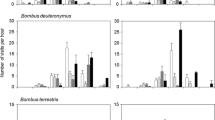Summary
Using removal experiments and concurrent measurement of resource levels, evidence was obtained for exploitation competition between Ruby-throated hummingbirds and two bumble bee species (Bombus fervidus and B. vagans) foraging for nectar on Impatiens biflora.
When all three species were active, flower visitors showed a complex pattern of resource partitioning involving both diel and spatial changes. Hummingbirds foraged almost exclusively from the outermost exposed flowers on plants from which they drained nectar levels beyond the reach of bees over most of the day. In contrast the longtongued bee species (B. fervidus), and the shorter-tongued B. vagans, displayed a preference for the innermost flowers on plants which were protected from hummingbird visitation by surrounding vegetation. The two Bombus spp. began foraging at different times during the day: B. vagans were most active in early morning but were replaced by B. fervidus later in the day.
When hummingbirds were rare, only B. fervidus showed evidence of competitive release: an increase in the number of foragers and a broadening of flower choice to include more outer flowers. Workers of B. vagans showed a similar response to temporary removal of B. fervidus and also extended their foraging over the entire day. These responses were consistent with changes in the availability of nectar to different species.
Removal experiments demonstrated that individuals of one species can be largely excluded from access to nectar resources as a direct result of exploitation of nectar by foragers of other species with longer tongues. Thus in this system interspecific exploitation is an important mechanism involved in resource partitioning.
Similar content being viewed by others
References
Brian AD (1957) Differences in the flowers visited by four species of bumble bee and their causes. J Anim Ecol 26:71–98
Carpenter LF (1979) Competition between hummingbirds and insects for nectar. Amer Zoo 19:1105–1114
Carpenter LF (1978) A spectrum of nectar-eater communities. Amer Zool 18:809–818
Chesson J (1978) Measuring preference in selective predation. Ecology 59:211–215
Connell JH (1983) On the prevalence and relative importance of interspecific competition: evidence from field experiments. Am Nat 122:661–696
Daniel WW (1978) Applied non-parametric statistics. Houghton Mitton Co, Boston
Feinsinger P (1976) Organization of a tropical guild of nectarivorous birds. Ecol Monog 46:257–291
Gill FB (1978) Proximate costs of competition for nectar. Amer Zool 18:753–763
Harder LD (1982) Measurement and estimation of functional proboscis length in bumblebees (Hymenoptera: Apidae). Can J Zoo 60:1073–1079
Heinrich B (1976a) Resource partitioning among some eusocial insects: bumblebees. Ecology 57:874–889
Heinrich B (1976b) The foraging specializations of individual bumblebees. Ecol Monogr 46:105–128
Heinrich B (1979) Bumblebee economics. Harvard University Press, Cambridge
Inouye DW (1978) Resource partitioning in bumblebees: experimental studies of foraging behavior. Ecology 59:672–678
Manley BFJ (1972) Tables for the analysis of selective predation experiments. Researches on Population Ecology, Kyoto 14:74–81
Morse DH (1977) Resource partitioning in bumblebees: the role of behavioral factors. Science 197:678–680
Morse DH (1982a) Behavior and Ecology of bumble bees. In: HR Herman (ed) Social Insects V 3, Academic Press, NY pp 245–322
Morse DH (1982b) Foraging relationships within a guild of bumble bees. Insectes Sociaux 29:445–454
Plowright RC, Laverty TM (1984) Ecology of bumble bees. Ann Rev Ent 29:175–199
Rust RW (1979) Pollination of Impatiens capensis and Impatiens pallida (Balsaminaceae). Bull Torr Bot Club 104:361–367
Rust RW (1979) Pollination of Impatiens capensis: pollinators and nectar robbers. J Kansas Ent Soc 52:297–308
Schoener TW (1983) Field experiments on interspecific competition. Am Nat 122:240–285
Author information
Authors and Affiliations
Rights and permissions
About this article
Cite this article
Laverty, T.M., Plowright, R.C. Competition between hummingbirds and bumble bees for nectar in flowers of Impatiens biflora . Oecologia 66, 25–32 (1985). https://doi.org/10.1007/BF00378548
Received:
Issue Date:
DOI: https://doi.org/10.1007/BF00378548




